Table of contents
- Comparison test, Ducati Sport 1000, Harley-Davidson XR 1200, Moto Guzzi V7, Moto Morini Scrambler Trend retro bikes
- Ducati Sport 1000 S.
- MOTO Guzzi V7 Cafe Classic
- Harley-Davidson XR 1200
- Moto Morini scrambler
- Triumph Thruxton
- MOTORCYCLE measurements
- MOTORCYCLE scoring
- The role models
- MOTORCYCLE test result
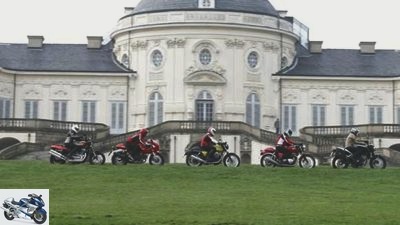
fact
motorcycles
Comparison test: trend retro bikes
Comparison test, Ducati Sport 1000, Harley-Davidson XR 1200, Moto Guzzi V7, Moto Morini Scrambler
Trend retro bikes
It is well known that everything was better in the past. Ducati, Moto Guzzi and Co. are therefore picking up on the good old days. Some more, some less and all in their own way.
Stefan Kaschel
10/22/2009
What is “retro”? Even if we usually deal with this word in a completely impartial way, the question must be allowed. Retro is omnipresent, retro is trendy. But what is retro? The search for the answer is no easier given the five motorcycles that have gathered in the Rococo ambience of Schloss Solitude at the gates of Stuttgart. And already suggests three different answers at the first fleeting contact. First: Retro is the combination of contemporary technology and a design language that is vaguely reminiscent of historical models. Moto Morini offers this recipe with the Scrambler and Harley-Davidson with the XR 1200 on. Retro light, so to speak, just for the eye, while everything else takes place in the usual performance and chassis dimensions. Second: Modern technology is not only combined with a rough appearance, but the historical model is largely reproduced. This inevitably also includes the ergonomics of bygone eras. The crouched lines, but above all the elongated, unusual seating position on a Ducati 1000 S make it clear what is meant. And thirdly, the engine and chassis components of the historical models are also measured and new motorcycles are put on the bikes that not only look classic, but also feel that way in almost every respect. Moto Guzzi went this way with the V7 Cafe Classic as well as Triumph with the Thruxton. So what is it “retro”? The first binding answer must be: “Retro” is charming in any case. Or the other way around: The beauty that yesterday’s designs still exude today is currently only rarely achieved, at least in the everyday motorcycle segment (Honda CBF, Suzuki Bandit, etc.). Not only because designers are increasingly subject to material and cost-saving constraints, but also because modern functionality is usually sober to unsightly.
Buy complete article

Comparison test
Trend retro bikes
13 pages) as PDF
€ 2.00
Buy now
Or can anyone remember once being as benevolently gazing at the mono strut of modern functional buildings in the dark depths of the frame triangle as the imposing strut duo of the Ducati 1000 S. Who is toying with the gray display field of a digital multifunctional instrument when two wonderfully drawn round instruments with a glittering chrome rim beckon next door? “Retro, that much seems clear, also means visible function. And it should have real pointers. Seen in this light, Moto Morini and Harley are falling behind.
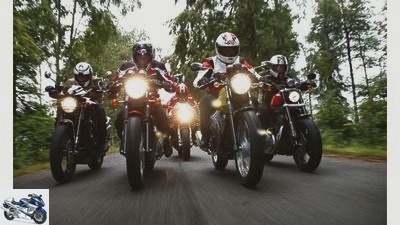
fact
Harley-Davidson XR 1200, Ducati Sport 1000 S, Moto Guzzi V7 Cafe Classic, Triumph Thruxton, Moto Morini Scrambler.
But of course, a gleaming chrome cockpit can’t be the only thing “retro” matters. At least not for those who know the sound of the past. Really robust, back then, when the noise limits were exceeded by crashing gearboxes, while Ducatis, Guzzis and Triumphs were allowed to roar to themselves on the exhaust side. But those times are over. Measured against back then, today, of all things, the hardcore retro bikes V7 (incidentally still with Lafranconi silencers as standard, which crackle wonderfully after the ride) and Thruxton whisper to themselves. Yes, even the Ducati, with its large-capacity 1000, is far more restrained when it comes to the rumble of the exhaust than the company’s current sporty products normally do. So it is reserved for the 1200s from Harley and Morini to underline the aged appearance with a reasonably appropriate pulse rate. But: so right “retro” that’s not even that, but what can you expect in times of noisy residents, strict TuV officials and busy police officers? Exactly! Neither do the explosions in the power of drives, the design drawings of which have survived almost unchanged over the decades in desks from Mandello to Milwaukee.
In this regard are in fact up to the Moto Morini all right “retro”. Cooled by the airstream, the gas exchange (except for Morini and Triumph) controlled by only two valves, ventilated by modest throttle valve housings, these engines do not perform any miracles in terms of performance. The drives from Ducati and Harley in particular show that the old formula, according to which there is no substitute for displacement, still applies. 1000 or more cubic centimeters, distributed over two cylinders, and everything is still in the paint, regardless of the top performance. The concentrated creative power of the Bologna Twin is between 3000 and 6000 rpm, and the Milwaukee V2 really does trumps between 2500 and 4000 rpm (see diagram on page 34).
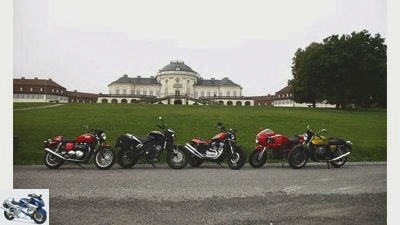
fact
Everything classic, or what? no rococo.
And with these traditionally designed performance characteristics, both of them never actually allow the desire for more modern designs to arise. Unless you previously had the pleasure of enjoying the short-stroke Morini twin with its unusual cylinder angle of 87 degrees. It has a small, barely noticeable hole at 3000 rpm. After that, however, a torque plateau piles up as far as the rev counter reaches. The modern four-valve engine works like Blucher between 3000 rpm and 7000 rpm. Jumps on the gas, literally on the gas, and turns up as lively as hardly anyone else, always supplied with plenty of fresh air and combustibles from the mighty 54 mm throttle valve slits and benevolent injection nozzles. But not in the astronomical regions of modern high-performance twins, but in very wholesome areas, because the forbidden red zone starts at 8500 rpm. Thanks to this limitation, the Morini-V2 may also look a bit like “retro” go through, but it still meets the needs of even the most progressive contemporaries exactly. The same cannot be said of the engines of the V7 and the Thruxton. The Guzzi should develop a moderate 48 hp from a displacement of 744 cubic centimeters, 46 of which can be proven on the test bench.
And the Triumph is also holding back in terms of performance. 69 HP (measured 68) from 865 cubic meters that would certainly have caused a sensation at the Bonneville, but by today’s standards it is an unspectacular affair. So unspectacular that performance-indulged contemporaries quickly fall asleep for the first few meters, because both here are worth a look at the torque curves on page 34 with practically no highlights. If anything, it’s the early climbs at 2500 rpm (Moto Guzzi) and 3000 rpm (Triumph) that cause a sensation. After that, life is a calm flow for both of them, the gearshift boxes have a break and the drivers have nothing to do but concentrate on their choice of line. It is very clear “retro”, But this is not due to the performance characteristics alone, but to the combination of an unexcited engine, clear dimensions and a chassis design that does not go along with the hype of modern wide tires or the smallest possible wheels.

fact
Harley-Davidson XR 1200, Ducati Sport 1000 S, Moto Guzzi V7 Cafe Classic, Triumph Thruxton, Moto Morini Scrambler.
18 inches at the front, plus 100 (Triumph) or 110 tires (Moto Guzzi) and moderate steering head angles of a good 60 degrees is a driving behavior that noticeably stands out from Ducati, Harley and Moto Morini. Definitely old fashioned but by no means bad. Above all, the Guzzi, with its low weight of 201 kilograms, scurries swiftly but never nervously through the winding curves and unmistakably reminds you that the modern tire formats 120/70 and 180/55 are image-enhancing, but by no means necessary to be brisk on the country road being. Filling the format, V7 and Thruxton are therefore wide in the rearview mirror and ensure that the two mighty 1200s and the sporty Ducati do not look back as relaxed as one might expect, given this type of motorcycle and the performance advantage. The two “Little ones” always keep up with the exit, are unspectacularly fast. It was the same in the past, when frames weren’t hopelessly undersized or spring elements bounced back and forth under dampening. Fortunately, neither is the case with the two modern classics. Retro at its best, especially since the Guzzi in particular has almost lost its typical peculiarity of bygone days, the abrupt tilting around the longitudinal axis when applying the gas.
Another typical weakness of this period, however, has remained. Despite the 320 mm disc and four-piston fixed calipers, the brake is of the kind that motorcycle generations had wanted to go to the moon before. Difficult to dose, hardly any effect, high hand strength to the retro feeling that undoubtedly contributes, it has never been good for driving fun.

fact
The five retro bikes in an inclined position.
That doesn’t mean that you want the radical stoppers of the XR 1200 or the Scrambler right away. On the contrary: precisely because they bite so powerfully, their drivers are confronted with new, unpleasant problems that were unknown to the historical models (which is clear in the case of the XR 1200, because the racing XR never had a front brake). Insufficient dosability with brutal effect is the keyword and in both cases this is a safety-relevant aspect to be taken seriously. If you are not careful, your front wheel is stationary. On the Harley, because the effect of the four-piston calipers increases enormously and Dunlop tires and fork provide little feedback. On the Morini, because the chunky Metzeler Karoo T, viewed benevolently, can at best pass as a fashion stunt. And not only when the front wheel is on the brakes again. Seriously: Anyone who willingly takes it “retro” ticked off, when the scrambler staggered like a battered boxer across the highway beyond 180 km / h or the rear tire at the exit of a curve bends over and over to the power of the 1200 and slips away heartily, this is a warrior of real shot and grain. One who would also kick a 1200 V2 unmoved. For everyone else, we urgently recommend ordering the Scrambler with a different set of initial tires, such as the optional Michelin Annakee. Then the Morini behaves much more civilized and not only loses its wobbly driving behavior and limited grip, but also noticeably increases in ride comfort (see Alpenmasters MOTORRAD 15 and 16/2009).
However, at the price of a much more civil appearance and a noticeably reduced retro attitude, which at best is still expressed in the lamp grille and exhaust duct. But hand on heart: Much more “retro” the Harley doesn’t have to offer either. Except maybe the fact that the robust engine vibrations in the push mode tingle noticeably in hands and feet, while the Milwaukee twin runs smoothly under load. Otherwise, however, the XR is as far removed from its role model, after all a thoroughbred racing device (see page 36), as the SPD is from government responsibility after the recent federal election. What does that mean? Very easily. The XR is far more Sportster than athlete at its heart. And a shot “retro” rides on almost every motorcycle from Milwaukee anyway. Simply because of the engine concept, the seating position, yes, the Harley philosophy. With the XR, this includes a transmission from the day before yesterday and inadequate chassis qualities, which are expressed in a poorly responsive upside-down fork, a board-hard rear and the idiosyncratic steering behavior. So it’s no wonder that one or the other contemporary likes to take a look at the beguiling Ducati next door. The 1000 S stands there like fresh from yesterday, takes over the lines of the famous Ahnin 750 SS almost one to one except for the wide bench seat and shines with a contemporary V2 and current chassis technology in a historical guise. There is no question that if the attention factor on the catwalk decides the retro rating, the Ducati 1000 S is unassailable. Just the shiny fork bridge, the chrome-plated fairing brackets, the gleaming steering damper. There is something. In addition, a splendid chassis, in which the stable upside-down fork guides just as neatly as the powerful swing arm made of round tube. The heavily decelerating, easy to dose 320 double disc system, the equally well-adhering and traditional-looking Pirelli Phantom Sportscomp tires would be done. In fact. If you didn’t have to sit up to go out. The exuberance is immediately followed by disillusionment. No, so damn … it couldn’t have been! At that time one never sat so fatally. With all the weight of the world on your wrists and with footrests in the usual chopper position. With this attitude, Paul Smart would never have won races. In this attitude, even normal motorcycle riders won’t win a flower pot on the Sunday ride. Retro or nostalgia. This is a real shame for the Ducati retro approach. Because it is actually a very promising way to recreate the timeless shapes of yesterday almost one-to-one, but to combine them with the latest technology. MOTORRAD has therefore given some thought to what an ideal retro bike from Germany could look like (see the following pages). But first of all you have to be satisfied with the existing concepts. And there it is the petite one Moto Guzzi and the serene Triumph, which not only invite you to travel in time while standing, but also on the exit, while Harley and Moto Morini are more at home in the here and now.
Ducati Sport 1000 S.
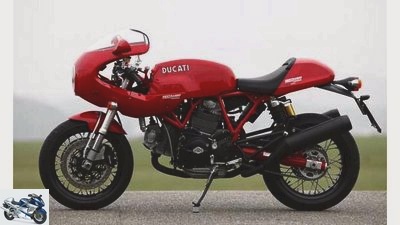
fact
Ducati Sport 1000 S..
Air-cooled two-cylinder four-stroke 90-degree V-engine, bore x stroke 94.0 x 71.5 mm, displacement 992 cm³, rated output 61.0 kW (83 PS) at 8000 / min, max. Torque 91 Nm at 6000 / min, seat height * 860 mm, weight with a full tank * 209 kg, load * 181 kg, tank capacity / reserve 15.0 / 3.5 liters, colors black, red, price 11,495 euros, additional costs around 255 euros
MOTO Guzzi V7 Cafe Classic
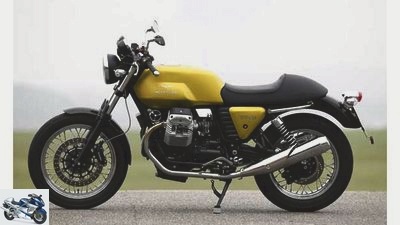
fact
MOTO Guzzi V7 Cafe Classic
Air-cooled two-cylinder four-stroke 90 degree V-engine, bore x stroke 80.0 x 74.0 mm, displacement 744 cm³, rated output 35.5 kW (48 PS) at 6800 rpm, max. Torque 55 Nm at 3600 / min, seat height * 810 mm, weight with a full tank * 201 kg, load * 200 kg, tank capacity / reserve 17.0 / 2.5 liters, colors white, green, price 8245 euros, additional costs around 255 euros
Harley-Davidson XR 1200

fact
Harley-Davidson XR 1200.
Air-cooled two-cylinder four-stroke 45 degree V engine, bore x stroke 88.9 x 96.8 mm, displacement 1202 cm³, rated output 67.0 kW (91 PS) at 7000 / min, max. Torque 100 Nm at 3700 / min, seat height * 795 mm, weight with a full tank * 263 kg, load * 176 kg, tank capacity / reserve 13.3 / 1.9 liters, colors orange, black, silver, price 11,170 euros, additional costs around 350 euros
Moto Morini scrambler
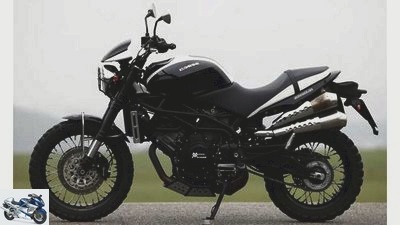
fact
Moto Morini scrambler.
Water-cooled two-cylinder four-stroke 87-degree V-engine, bore x stroke 107.0 x 66.0 mm, displacement 1187 cm³, rated output 85.0 kW (116 PS) at 8500 rpm, max. Torque 102 Nm at 6750 / min, seat height * 850 mm, weight with a full tank * 222 kg, load * 173 kg, tank capacity / reserve 21.0 / 4.5 liters, colors black / white, white / red, price 11,795 euros, additional costs around 250 euros
Triumph Thruxton
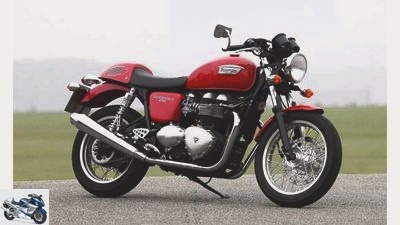
fact
Triumph Thruxton.
Air-cooled two-cylinder four-stroke in-line engine, bore x stroke 90.0 x 68.0 mm, displacement 865 cm³, rated output 51.0 kW (69 PS) at 7400 / min, max. Torque 70 Nm at 5800 / min, seat height * 830 mm, weight with a full tank * 231 kg, load * 199 kg, tank capacity 16.0 liters, colors red, black, price 8990 euros, additional costs around 250 euros
MOTORCYCLE measurements
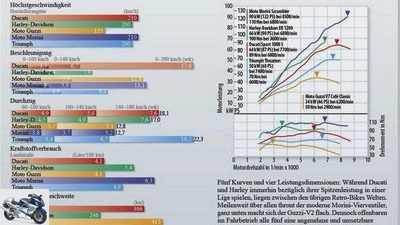
BILLION
Comparison test of retro bikes: MOTORCYCLE measurements
MOTORCYCLE scoring
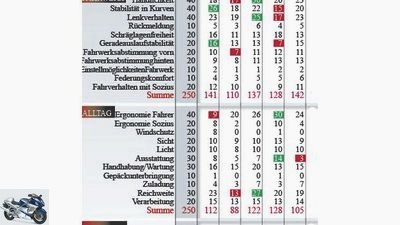
BILLION
MOTOR: No more retro now:
Viewed through sober scoring glasses, the Morini construction cannot be topped. When it comes to driving performance alone, it brings out a considerable lead and otherwise shines with good manners. It is also noteworthy, however, that the Ducati-Twin may not have the power and magnificence of the Morini-V2, but otherwise – apart from the stiff clutch – leaves nothing to be desired. The Harley-Big-Twin, on the other hand, can hardly place itself in front of the Triumph engine because of its heavy vibrations in push mode, but also because of the mediocre gearbox. The Guzzi-V2 naturally falls off, but presents itself very balanced.
Winner engine: Moto Morini
CHASSIS: surprise, surprise:
Ducati and Triumph on the same level, the little Guzzi (and that as a single-seater!) Follows immediately. However, this order only comes about because the coarse Metzeler Karoo of the Morini completely ruined the rating. The retro ambience comes at a high price here, while the Triumph and the Guzzi surprise with really fine manners. They make the retro feeling a real pleasure. That would also be possible on the Ducati, because the chassis is quite convincing. It fails because of the sitting position, see chapter ergonomics. With the Harley, on the other hand, it is fundamental factors such as stability, steering behavior and feedback that cost points.
Chassis winner: triumph
EVERYDAY LIFE: And again the Guzzi is at the front, and that, although she is not allowed to carry a pillion passenger. Ultimately, however, the Morini wins the race because
not only ergonomically, but also in terms of equipment. Speaking of ergonomics: Even nine out of 40 points do not adequately express what the classic enthusiast has to endure on the 1000 S, and the XR 1200 does not cover itself with fame in this respect either. For those who like to travel in pairs, the Scrambler comes first, but then the payload will be tight.
Winner everyday: Moto Morini
SAFETY: ABS and retro don’t go together? Seems so, because none of the five time irons has ABS on board. Above all, the XR 1200 with its difficult braking behavior and the Morini with its unsuitable tires would be urgently needed. The Guzzi bleeds again for the fact that a pillion rider is left out, Morini and Ducati tend to kickback.
Safety winner: Moto Morini
COST: Modesty is an ornament and also really scores points. Narrow tires, narrow performance, narrow thirst – the Guzzi wins this chapter ahead of the Triumph and the rest of the retro world.
Winner cost: Moto Guzzi
Price-performance winner: Moto Guzzi / Triumph
The full-size retros are also in the chapter “Motorbike for the money” front. Perhaps looking back is also one of the future of the motorcycle.
The role models

archive
The role model.
Ducati
72 hp at 8000 rpm, a weight of 200 kilograms with a full tank – in terms of performance and weight, the original 750 SS from 1973/74 is far from the 1000 successor. At that time it cost 9,990 marks.
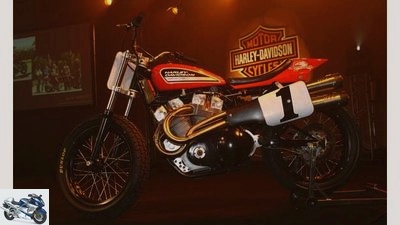
manufacturer
The role model.
Harley-Davidson
Even if the name XR suggests a relationship: apart from formal similarities, the XR 750 and XR 1200 have nothing in common. Not even the front brake, because a dirt track bike doesn’t have any. But between 90 and 100 hp.
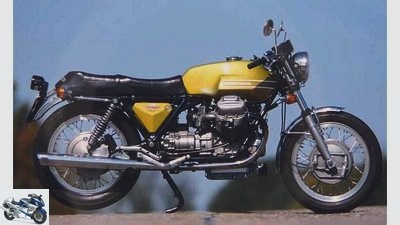
archive
The role model.
Moto Guzzi
Original and replica – with Moto Guzzi it is hard to tell apart. The new one is nine kilograms lighter, but also nominally 24 hp weaker than the historical model. The price back then: 7,995 marks in 1974.
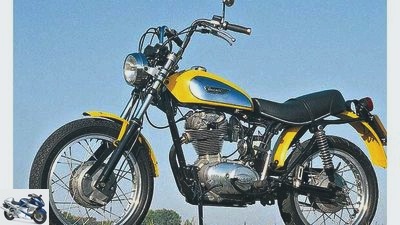
archive
The role model.
Moto Morini
Yes, there was a Morini Scrambler with a single cylinder engine and a maximum of 153 cubic centimeters. The Ducati Scrambler with displacements between 250 and 450 cubic centimeters is more likely to go through as a historical model.
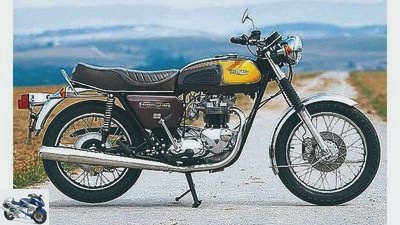
archive
The role model.
triumph
Originally with 650, later also with 750 cubic centimeters, the Bonneville was launched and developed 48 and 53 hp respectively. In terms of weight, the Bonneville was 196 kilograms and its price was 5150 (5860) marks.
MOTORCYCLE test result

fact
Who is the retro queen?
Who is the retro queen? The Ducati 1000 S gambled away the imaginary title with its merciless seating position. Moto Guzzi and Triumph, on the other hand, show that “retro” not just a glorified look back, it can be a serious option in modern times. Harley and Moto Morini, on the other hand, have made a nostalgic bow about their current productions.
Related articles
-
Gargolov motorcycles Comparison test: big bikes Comparison test: Big Bikes from Honda and Suzuki Test: Honda CBF 1000 F, CB 1300 S and Suzuki Bandit 1250…
-
Comparison test: large naked bikes
K motorcycles Comparison test: large naked bikes Comparison test: Large naked bikes, Ducati Monster S4, Kawasaki Z 1000, KTM 990 Super Duke R, Triumph…
-
Three scramblers in a retro comparison test
fact / Joachim Schahl motorcycles Modern Classic Three scramblers in a retro comparison test Three scramblers in a retro comparison test New Kid in Town…
-
Overview of retro bikes and modern classics
Jorg Kunstle 43 pictures Benelli 1/43 Benelli Imperiale (Euro 4): 373 cm³ displacement, 21 HP, suitable for A2. BMW 2/43 BMW R nineT: 1,170 cm³…
-
Comparison test: BMW R 1200 GS, Ducati Hypermotard 1100 S, KTM 990 Supermoto
Jahn motorcycles Comparison test: BMW R 1200 GS, Ducati Hypermotard 1100 S, KTM 990 Supermoto Comparison test: BMW R 1200 GS, Ducati Hypermotard 1100 S,…
-
Honda CBR 300 R and Honda CBR 500 R in comparison test
Gargolov 33 pictures Rossen Gargolov 1/33 Two against one is not fair? We see how the single-cylinder Honda CBR 300 R fares against the two-cylinder…
-
Mid-range naked bikes in a comparison test
fact 23 pictures fact 1/23 The middle class has changed. 100 hp, at least 750 cc and 200 km / h are nothing unusual here. fact 2/23 We test three…
-
Mid-range crossover bikes in a comparison test
www.factstudio.de 32 pictures www.factstudio.de 1/32 Pepped up: The Honda NC 750 X was the only bike in the test field to be revised for this year……
-
Comparison test: Kawasaki ZX-6R in three expansion stages
Jahn motorcycles Comparison test: Kawasaki ZX-6R in three expansion stages Comparison test: Kawasaki ZX-6R in three expansion stages Queen, King, Ace…
-
Comparison test: Honda CBF 1000 Silverline, Suzuki Bandit 1250 S, Yamaha FZ1 Fazer
Jahn 22nd pictures Honda 1/22 Honda CBF 1000 Honda 2/22 Honda CBF 1000 Zdrahal 3/22 Presentation at the fair in Paris. Honda 4/22 Honda CBF 1000 Honda…